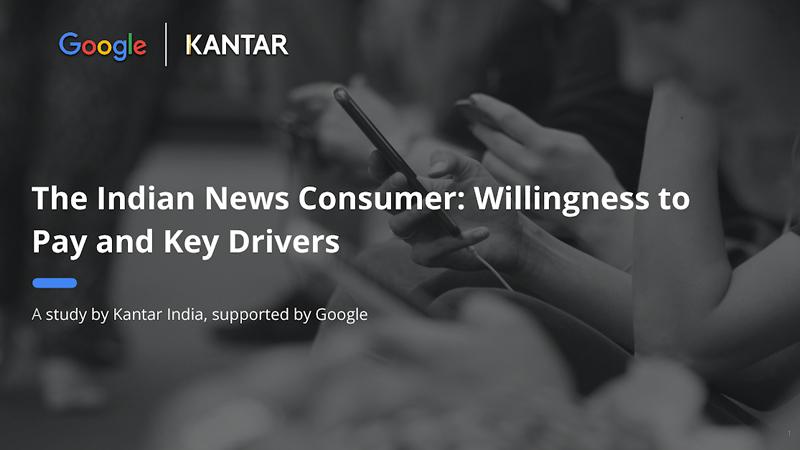Mumbai: Google, in partnership with Kantar, has released a new research report titled, "The Indian News Consumer: Willingness to Pay and Key Drivers" at the third edition of the Google News Summit.
At a time when newsrooms are experimenting with different combinations of formats, revenue streams and content types, the study shines a light on the levers that drive online news subscriptions and how these vary across languages. The study incorporates qualitative and quantitative data from over 2000 respondents and nine languages. The insights aim to equip publishers with the knowledge to navigate the digital landscape, capitalise on reader revenue opportunities, and foster sustainable growth, particularly in local language markets.
Shedding more light on the findings of the research, Kantar director - B2B & technology, Biswapriya Bhattacharjee said, "Indian digital news consumers increasingly crave immersive, more relevant news consumption experiences, creating a prime opportunity for premium offerings. However, the price-sensitive nature of the market necessitates a diversified revenue strategy. What also comes out strongly is that in order to expand the user base, a meaningfully different and well-communicated value proposition is essential.”
Google India head of India news partnerships, Durga Raghunath said, “The Indian digital news market is experiencing dynamic growth, driven by increasing internet penetration and an expanding ecosystem of local language publishers. Understanding the nuances of reader revenue models is crucial for the sustainability and growth of digital news. As part of our ongoing efforts to support the news ecosystem, this research provides valuable insights into reader preferences and behaviors, empowering publishers to make informed decisions about their monetisation strategies and build stronger connections with their audiences."
Understanding barriers and opportunities for reader revenue in India:
Users, while recognising the value of quality journalism, are overwhelmingly driven by convenience and deterred by cost and a lack of clarity regarding the value proposition of paid subscriptions.
● 67 per cent of current subscribers in the study cited "reliable content" as a primary factor in their decision to subscribe.
● Among those who haven't subscribed, the top three barriers cited are "overwhelmed by too many plans/prices" (39 per cent), "limited budget" (35 per cent), and "lack of flexible payment/cancellation options" (33 per cent). This contrast underscores the need for publishers to clearly articulate the value proposition behind each while addressing pricing and flexibility concerns.
● Once again, user preferences vary interestingly by language. The study consistently reveals that "news in the preferred language" is a highly valued content element across various language groups, including Hindi (67 per cent), Bengali (75 per cent), Tamil (63 per cent), and Gujarati (79 per cent).
While subscription and other revenue models have varying appeal, the overall willingness to pay for digital news content, whether through subscriptions or other models, is comparable between local language and English language news consumers in India.
● Both Kannada and Tamil speakers are relatively more receptive to subscriptions. They are also open to sharing first-party data and micro-transactions in the form of either pay-per-content or mini-access pass.
● In contrast, first-party data is likely to be the way to unlock value with Bengali and Malayalam speakers. This diversity provides publishers with a wider range of revenue models to explore.
Opportunities for news publishers
● Marketing a clear value proposition: Publishers need to bridge the gap between subscription offerings and audience understanding of the key value proposition. Highlight the unique value of content, emphasizing features like in-depth reporting and specialised coverage not available for free.
● Simplify and streamline subscription: Prioritise transparent pricing, simplification, and flexibility. Offering clear pricing, easy cancellation, and sufficient free trials can build trust, demonstrate value and drive conversions.
● Diversify revenue streams: One size doesn't fit all. Experiment with micro-transactions, first-party data sharing, and ad-supported models alongside subscriptions.
● While users value ad-free experiences, affordability is an important consideration. Consider a hybrid model offering a small subscription fee with limited ads. Invest in robust newsletters to cultivate a loyal audience and provide additional value.
● Offer flexibility and control: Empower users with flexible payment options like shorter billing cycles and customisable plans. While free trials attract new subscribers, focus on long-term value through bundled plans to ensure retention. Features like saving articles and content filtering provide greater control over their news experience.
● Elevate the Indic language experience: The research also reveals that Indic language publications often encounter difficulties navigating subscription processes and accessing content. Dedicate resources to build a seamless experience for Indic language users, including intuitive interface design and easy language-switching functionality.
While barriers to paid subscriptions exist, so do substantial opportunities. By prioritising a clear value proposition, a user-centric approach to design and functionality, payment flexibility, and tailored strategies based on language demographics, news publishers can enhance user confidence, increase willingness to subscribe, and drive growth in the evolving digital landscape.
 Follow Us
Follow Us





